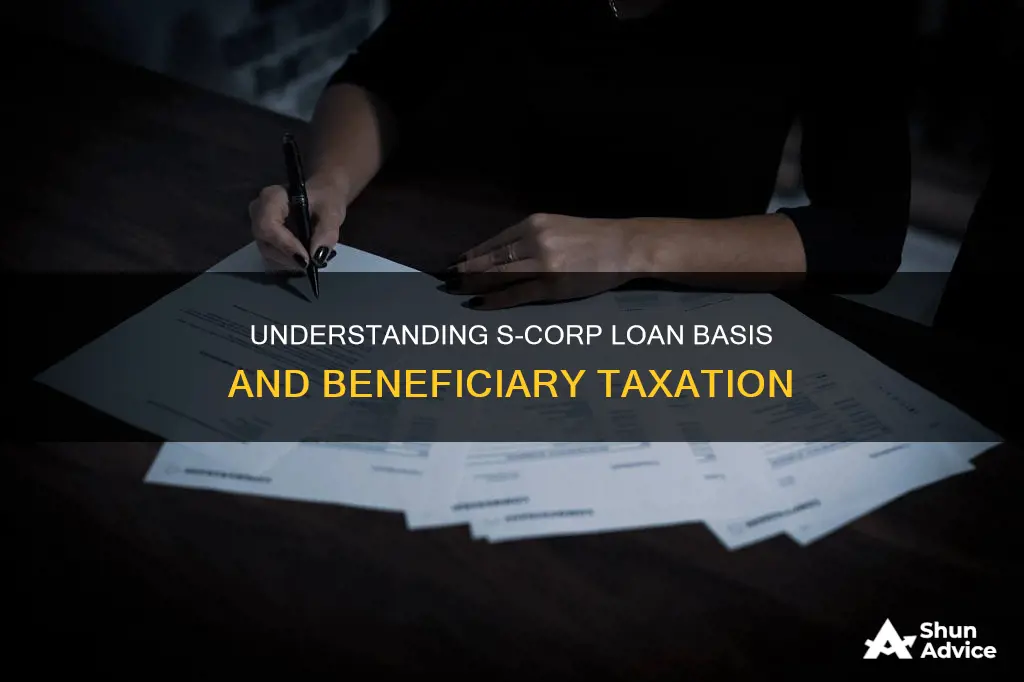
Understanding how loans are treated in an S-Corporation is critical for shareholders to maximize their deductible passthrough losses and reduce their tax liability. When an S-Corporation shareholder makes a direct loan to the company, they establish a debt basis, which is essential for claiming losses on their individual tax returns. However, it's important to distinguish between a loan guarantee and a bona fide debt, as only the latter, characterized by a valid debtor-creditor relationship and a fixed repayment schedule, creates a debt basis. Shareholders must also be aware of the at-risk and passive activity loss limitations, which may further impact their ability to claim losses. Proper record-keeping and compliance with basis tracking requirements, such as Form 7203, are crucial for shareholders to effectively manage their tax obligations and make informed decisions regarding their investments in the S-Corporation.
| Characteristics | Values |
|---|---|
| Shareholder's guarantee of a loan to an S corporation | Not an actual economic outlay and therefore does not increase the shareholder's debt basis in the S corporation |
| Bona fide debt | Arises from a debtor-creditor relationship based on a valid and enforceable obligation to pay a fixed or determinable amount of money |
| Debt basis | Computed similarly to stock basis but with some differences |
| Shareholder's stock and debt basis in the S corporation | Important for determining the taxability of a non-dividend distribution |
| Shareholder's loan basis | Can be used to deduct passthrough losses on individual tax returns |
| Shareholder's basis in an S corporation | Determined by the original purchase of stock, additional equity contributions, and cumulative net income less distributions passed through during the ownership period |
| Nondividend distributions | Reduce stock basis but do not reduce debt basis |
| Passthrough loss | Can be carried forward indefinitely if the taxpayer lacks sufficient basis to deduct the loss in the current tax year |
| Debt to qualify as S corporation basis | Must run directly from the shareholder to the S corporation and must be bona fide |
| Basis tracking | Burden falls on the shareholder, not the S corporation |
| Basis | Amount of investment the taxpayer has in the business |
| Adjusted basis | Result of shareholder's initial basis after adjusting for their share of the S corporation's income, loss, and other items |
| Corporate repayment of loans | Reduces the shareholder's basis in such loans |
| Partial repayment of a shareholder loan | Represents income to the shareholder |
What You'll Learn

Shareholder loan requirements
Shareholder loans are a way to move money into or out of a business. They can be loans from shareholders, where a shareholder provides a loan to the business, or loans to shareholders, where the business loans money to a shareholder. Shareholder loans can be a useful tool for tax planning, but they are also subject to strict regulations and can lead to costly tax mistakes if not properly understood and managed.
For S corporations, shareholder loan requirements are particularly important. To acquire an S corporation basis, a shareholder must purchase stock, make additional equity contributions, and generate cumulative net income, less distributions passed through to the shareholder during the time the stock is owned. Shareholders can also acquire debt basis from loans made to the S corporation. It is important to note that non-dividend distributions reduce stock basis but do not reduce debt basis.
To qualify as an S corporation basis, the debt must run directly from the shareholder to the S corporation, and the indebtedness must be bona fide. This means that there must be a valid debtor-creditor relationship, with a real expectation of repayment and intent to enforce collection efforts in the event of default. The loan must also be structured properly, with the corporation making payments directly to the shareholder. Courts will evaluate the financial condition of the S corporation to ensure that the loan supports an expectation of repayment and that the shareholder has collateralized the loan with their personal property.
To comply with IRS requirements, a formal written loan agreement must outline the details of the loan, including the exact loan amount, interest rate, monthly payments, and duration of the loan. The interest rate should be above the Applicable Federal Rate (AFR) to meet the arms-length requirement and avoid triggering an audit. Shareholders must report the interest paid on the loan for their personal tax returns and fill out Form 1099-INT to outline the interest paid to the corporation.
Prosper Loan Income Verification: What You Need to Know
You may want to see also

Loan structure
For an S corporation, the loan structure is critical to establishing basis. A legitimate loan has written terms, interest, a repayment schedule, and is treated as a debt in the company's books. The loan must be structured as a bona fide debt, with the corporation making payments on the loans directly to the shareholder. This will support the debt basis for the shareholder to use to deduct passthrough losses on their individual tax return.
To qualify as a bona fide debt, the loan must run directly from the shareholder to the S corporation, and the indebtedness must be valid and enforceable. The shareholder must have a real expectation of repayment and the intent to enforce collection efforts in the event of a default. The source of the funds is also important; a loan from an unrelated third party such as a bank is more likely to be considered a bona fide debt than a loan from related parties or entities with common ownership.
The flow of funds is critical to establishing basis. For example, in the case of Phillips, she should have structured the loans so that she was the primary obligor, with the S corporation as the guarantor. The bank should have distributed the loan proceeds to Phillips personally, and she should have then loaned the money directly to the S corporation. This back-to-back loan structure would have proven that the lender intended to make the loan to the S corporation shareholder.
In addition, it is important to document the intent of the parties by characterizing the transaction as a loan in the corporate resolutions and accounting records. The parties should maintain written notes with a fixed repayment schedule and a fair market rate of interest at least equal to the applicable federal rate. This documentation is critical to avoiding IRS scrutiny and establishing that the loan is not a constructive dividend, an attempt to avoid payroll or distribution rules.
By structuring the loan properly, shareholders can unlock valuable tax planning benefits, such as the deductibility of losses, deferral of distributions, and capital gain treatment.
Refinancing: Does It Cancel Your Existing Loan?
You may want to see also

Tax implications
S corporations are considered pass-through entities, meaning that income and losses are passed through to shareholders, who are taxed on their individual income tax returns. Shareholders acquire S corporation basis through the original purchase of stock, additional equity contributions, and cumulative net income, less distributions passed through during the time the stock is owned.
Shareholders can also acquire debt basis from loans made to the S corporation. Nondividend distributions reduce stock basis but do not reduce debt basis. Shareholders must have adequate stock and/or debt basis to claim losses and/or deduction items. To determine the taxable amount of a distribution, shareholders must refer to their stock basis, as debt basis is not considered in this calculation.
If a shareholder has S corporation loss and deduction items in excess of stock basis and those losses and deductions are claimed based on debt basis, the debt basis of the shareholder will be reduced by the claimed losses and deductions. If an S corporation repays reduced basis debt to the shareholder, part or all of the repayment is taxable to the shareholder.
To qualify as S corporation basis, debt must run directly from the shareholder to the S corporation, and the indebtedness must be bona fide. Courts will evaluate the financial condition of the S corporation debtor when the loan was made to ensure an expectation of repayment and an intent to create a valid debtor-creditor relationship. The shareholder should personally make the payment on the bank debt and receive repayment from the S corporation, rather than the S corporation paying the bank directly.
Thoughtful and careful loan structuring will allow shareholders to use passthrough losses in the current year rather than suspending their use to future years, lowering the shareholder's tax liability.
Remington College Student Loans: Interest Charged?
You may want to see also

Basis tracking
If a shareholder is allocated an item of S corporation loss or deduction, they must first have adequate stock and/or debt basis to claim that loss and/or deduction item. Even when the shareholder has adequate stock and/or debt basis to claim the S corporation loss or deduction item, the shareholder must also consider the at-risk and passive activity loss limitations and therefore may not be able to claim the loss and/or deduction item.
To ensure proper basis tracking, it is important to document the intent of the parties by characterizing the transaction as a loan in the corporate resolutions and accounting records. The parties should maintain written notes with a fixed repayment schedule and a fair market rate of interest at least equal to the applicable federal rate.
Starting in the tax year 2021, shareholders are required to file Form 7203, S Corporation Shareholder and Debt Basis Limitations, and attach it to their Form 1040 to track and report their stock and debt basis. If a shareholder has not kept track of their stock and debt basis, it is important to start today. This includes collecting prior-year K-1s and capital contribution records from the day the investment in the S Corporation began.
By understanding S corporation basis rules, practitioners can assist clients in taking advantage of planning opportunities aimed at maximizing deductible passthrough losses and lowering the shareholder’s tax liability.
Prime Lending: Selling Loans and Mortgage Deals
You may want to see also

Bona fide debt
For a debt to qualify as a bona fide debt, it must meet two requirements. Firstly, the debt must run directly from the shareholder to the S corporation. Secondly, the indebtedness must be bona fide, as per Regs. Sec. 1.1366-2(a)(2). Whether indebtedness to a shareholder is bona fide is determined by general federal tax principles, which consider the facts and circumstances of the loan. Bona fide debt is defined as arising from a debtor-creditor relationship based on a valid and enforceable obligation to pay a fixed or determinable amount of money.
Courts will evaluate the financial condition of the S corporation debtor when the loan was made to ensure an expectation of repayment and an intent to create a valid debtor-creditor relationship. The courts have also found it important that the shareholder collateralize the loan with their personal property. The definition of bona fide debt is clear when the source of the funds is an unrelated third party, such as a bank. In this case, the shareholder borrows funds from a bank and lends the cash to the S corporation, and the bank holds the shareholder to the repayment terms.
The conclusion becomes less clear when the loan is made between related parties or between the shareholder and entities with common ownership. In these situations, it is important to document the intent of the parties by characterizing the transaction as a loan in the corporate resolutions and accounting records. The parties should maintain written notes with a fixed repayment schedule and a fair market rate of interest at least equal to the applicable federal rate. The parties should also respect the loan structure and meet the definition of a bona fide debt by having the corporation make payments on the loans from the shareholder directly to the shareholder.
Additionally, the shareholder should personally make the payment on the bank debt. This planning tool will support the debt basis for the shareholder to use to deduct passthrough losses on their individual tax return. Thoughtful and careful loan structuring will allow shareholders to use passthrough losses in the current year rather than suspending their use to future years.
PSLF Loan Forgiveness for Graduate Degree Programs
You may want to see also
Frequently asked questions
A shareholder acquires S corporation basis through the original purchase of stock, additional equity contributions, and cumulative net income, less distributions passed through to the shareholder during the time the stock is owned.
A shareholder acquires debt basis from loans made to the S corporation. It is important to note that non-dividend distributions reduce stock basis but do not reduce debt basis.
A deductible passthrough loss refers to the losses that are passed through from an S Corporation to its shareholders. These losses are deductible on the shareholder's individual tax return, but cannot exceed the shareholder's adjusted basis of stock in the S corporation.
Yes, an S-corporation loan basis can pass through to a beneficiary, but only when the S Corporation owes the shareholder directly. If the shareholder personally guarantees an S Corporation's loan to third parties, this does not constitute debt basis.







